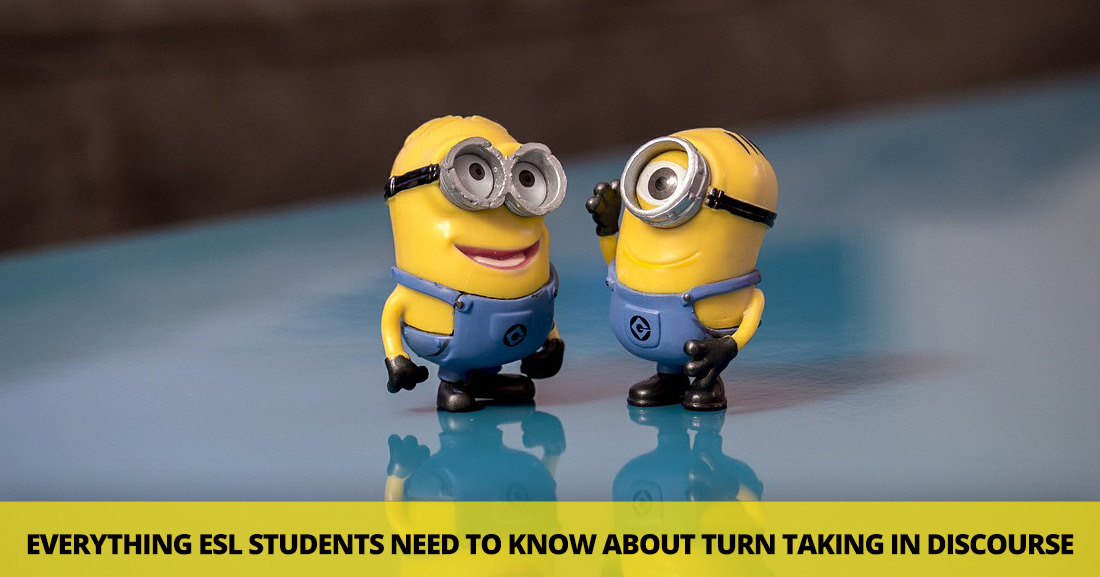Everybody Take Your Turn: Everything ESL Students Need to Know about Turn Taking in Discourse


ESL students learn a variety of skills in the classroom, and strategies for listening, writing or reading. They can certainly speak in class, but is answering your questions the same as speaking? Can your students carry a conversation with another English speaker? How long can they keep one discussion going? The reason these questions are important is that ultimately this is exactly what ESL students hope to accomplish: they want to gain the level of proficiency that will allow them to engage English speakers in conversation. And to reach this level of proficiency, the ability to take longer turns and turn-taking skills are absolutely essential.

Quite literally, we’re talking about taking turns to speak. So, if you tell a group they have to plan a party together, the students should take turns providing ideas, offering to do something or giving opinions. What happens most often in the ESL classroom is that one or a few of the students dominate the conversation, giving the others very short turns. Another common scenario, when students are divided into pairs, is that both students take turns to speak, but end the conversation in a matter of seconds, i.e. the talk is cut short simply because they don’t know how to keep it going. So, here are some tips, just a few ideas that should help your students have longer and better conversations/discussions.


When you ask someone a direct question, you’re forcing them to take their turn. One great strategy is to divide students into pairs to discuss a topic and instruct them to do the following: one student has to get the ball rolling with his/her opinion, then ask his/her partner a question. Say the topic is “Cell Phone Use – How much is too much?”
S1: The first thing I do after I wake up is check my phone. How about you?
S2: First, I have breakfast and turn on my computer, then I turn on my phone. Do you check your phone for messages all the time?
S1: Constantly! I can’t stop checking messages! How many messages do you think you send per day?
Etc…
As you can see, questions can help move the conversation along nicely! This is a great strategy for beginners to intermediate students who need that little extra push to speak.
Conjunctions and connectors like however, on the contrary or as a result, help students get used to taking longer turns. Try this strategy. Write down a list of conjunctions on the board or on a piece of paper. Each student has to say something and then add more information by using a conjunction: I went to the movies last weekend. In fact, I go to the movies every weekend. Cross out this conjunction, thus forcing the other students to use the rest. This is a great way to practice these as new vocabulary, but it also helps students speak a little longer.
Another great way to keep the conversation going is by agreeing/disagreeing with what another student has said. Some of the phrases you can teach include:
Just like the above skill, it’s very important for students to be able to not only express their opinions, but also ask others for their own. Some of the phrases that come in handy in this case are:
One of the things that can scare any ESL student is not knowing what to say. Long silences are awkward. So teach them useful phrases that act as fillers, thinking words they can turn to when they need time to come up with an appropriate response. Some of these fillers include:
Another important skill is being able to avoid being interrupted. If you start by saying, “There are three things I would love to do before I die” then the others will have to wait to hear what those three things are before they can add their own thoughts. Another strategy is to begin the sentence with a clause: Although I …/Even though I…Because they... This way those who are listening will have to wait until they hear both clauses.
When encouraging students to take longer turns speaking, I recommend keeping corrections to a minimum. In fact, consider simply letting them speak and giving them feedback at the end. This works for two reasons. If you insist on correcting them, you will not only interrupt their train of thought (which they are trying so hard to keep!) but it will also affect their confidence. So, when they’re done speaking, offer some suggestions for improvement. But don’t forget to offer praise as well!
And through it all, they don’t want to embarrass themselves in front of their classmates. It’s not easy for them to get used to speaking longer. But if you guide them with the right steps, and provide the right strategies, you will have more confident speakers.
* This question was sent in from a real ESL teacher, just like you! If you need any advice on a particular topic, share your question in the comments below. Or tweet your question to @busyteacher_org with the hashtag #ESLTeachersAsk. Your question might get picked and featured in an article!